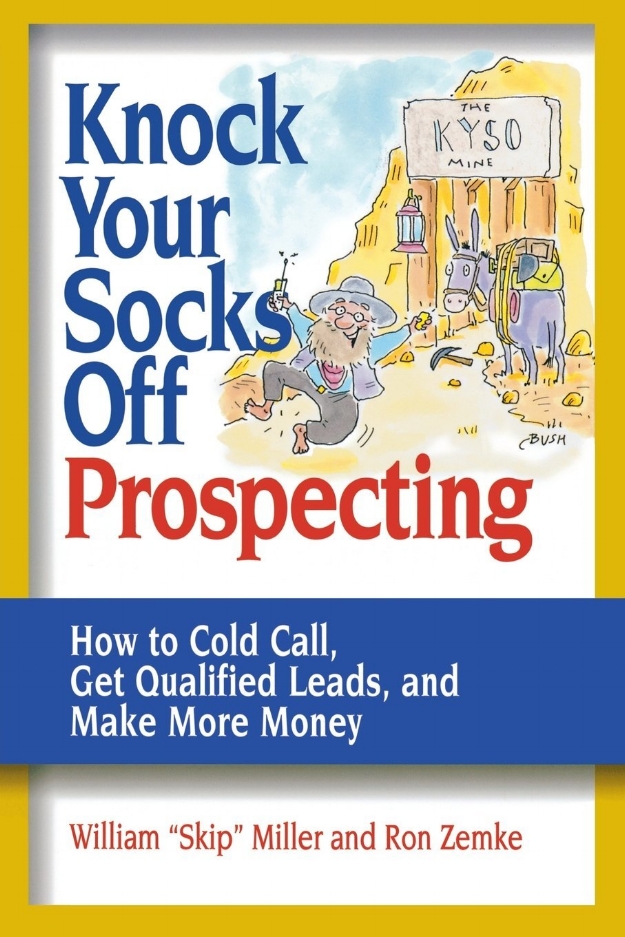BOOK FACTS
- Title: “Knock Your Socks Off Prospecting: How to Cold Call, Get Qualified Leads, and Make More Money”
- Author: William Miller and Ron Zemke
- Publisher: AMACOM, New York
- Copyright: 2005
- No. of Pages: 158
- No. of Chapters: 29
RATING: (5 IS A MUST READ – 1 IS LOW INTEREST IN READING)
Readibility: 5
Maintains Attention: 5
Applicability of Information: 5
REVIEW
As a student of effective sales and sales processes, Miller and Zemke’s “Knock Your Socks Off Prospecting” is a very hands on and application oriented book. They write in a clear, concise and practical manner. Miller and Zemke utilize stories and examples to bring their point’s home. If you are looking for a book that will give you tools that can be used immediately, then this is a book for you.
Miller and Zemke’s “Knock Your Socks Off Prospecting” offers hands-on support in enhancing your efforts to cold call, find new prospects and ultimately increase your sales. They walk you through specific examples and phrases you can use throughout the sales process. Miller and Zemke’s book helps novice sales people think through and develop their own phrases, questions and thoughts on developing prospects and leading them to a sale. They do a wonderful job of taking the fear out of cold calling and selling. For many of us, cold calls are our worst nightmare. Miller and Zemke take the fear out of cold calls and selling by helping us develop our own style that we can be completely comfortable with.
Miller and Zemke’s “Knock Your Socks Off Prospecting” is one of the best books I have read regarding effective sales strategies and tips. Miller and Zemke’s book requires reading and practicing. This is not a book to simply read through and then let it go. This book offers such practical strategies that you can start implementing them the day you read it.
SUMMARY OF MAIN POINTS
Miller and Zemke’s “Knock Your Socks Off Prospecting” discusses numerous strategies and concepts of effective cold calling and prospecting. Miller and Zemke focus on three specific areas of the sales process:
- The fundamentals of prospecting
- The how-to’s of cold calling
- Follow up
THE FUNDAMENTALS OF PROSPECTING
They start the process by sharing three rules for success: be positive, be aggressive and be persistent. A positive attitude is contagious. Prospects can see right through us when we hate prospecting but we try anyway.
“There is a fine line between aggressive and obnoxious. What’s the difference? The aggressive salesperson wants to help the prospect; the obnoxious one just wants to help himself. Aggressive salespeople genuinely believe that what they have to offer will help their prospect in a big way.”
Persistent people don’t give up in spite of failures. They take failure and learn from it in an effort to turn it into success.
Miller and Zemke discuss the critical point that sales needs to focus on the customer. “In sales, and especially in cold calling, it’s all about THEM.” I really appreciate their focus on people and not on the sale itself. In order to achieve true success in sales we need to focus on the potential customers and not on our own needs.
They discuss a variety of other specific principles and strategies such as time management and working the numbers of calls you make. They focus the end of this section on the concept of not selling stuff, but selling solutions. We need to pay attention to what the customer needs to help them be successful and then help them see how what we offer can help them achieve their goals.
THE HOW-TO’S OF COLD CALLING
I found this section to be very powerful. Miller and Zemke walk you through step by step the cold calling process. They discuss how to develop your own thirty second speech. Through their guidance you not only can develop your own thirty second speech but you will be able to develop several variations of your thirty second speech so you are prepared for a variety of situations.
Another critical aspect of cold calling is the messages we leave. We have all left messages and then been completely frustrated that no one ever calls us back. This section addresses this issue in detail. You will learn how to leave messages that cause prospects to call back and inquire to what you have to offer. Wouldn’t we all love for our messages to be returned?
In closing this section Miller and Zemke walk you through the buying process. If we know what leads prospects to buying then we will have greater success in selling. The key to this is allowing the prospect to drive the process while we remain in control of the direction. This may sound a bit confusing but once you have read the chapters in this section this concept will become very clear. They also discuss the infamous “no” response. How do we handle prospects who say no? They challenge us to determine what the prospect is saying no to and then dealing with the real issues.
FOLLOW UP
Miller and Zemke walk you through what to do next once you have been successful in scheduling meetings with the prospect. They share that people do not like to be sold to or at, they like to maintain control in the process. The idea is for us as the salesperson to control the prospect but to control the sales process. “Knock Your Socks Off Prospecting is not just about who can get the appointments. It’s about who can maintain the momentum.”
This section walks you through a three step process: Introduction; Their goals and objectives; and Today’s agenda. You will learn how to prepare for the meeting and then lead the prospect to a sale. “The solution path is all about what you can do for your prospects. How will you help meet their needs? How will you help them solve a problem or seize an opportunity? How will you help them implement what you are selling so the result is happy customers?”
CALL TO ACTION
The following five strategies are recommended to enhance the effectiveness of your sales efforts:
1. Remember that the entire sales process is all about the customer, not you.
2. You have 4 to 6 seconds to make a good first impression and you have 30 seconds before the customer wants to be part of the conversation.
3. Craft your 30 second speech around three points:
o “Who are you?”
o “What’s in it for people like me?”
o “What’s in it for me? (WIIFM)”
4. “Focus on the prospects goals and objectives. Find a solution to the prospect’s problems.”
5. “Mix up your 1-3-5 communications by leaving, say, one voice message, one email, then another voice message. Choose fax, email, phone, pager, letter, or personal visit – whatever mix of communication you feel will be most effective.


